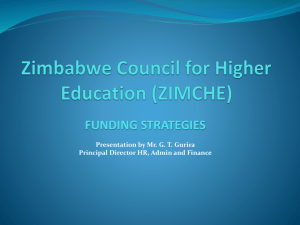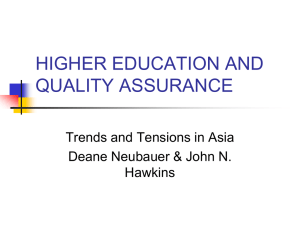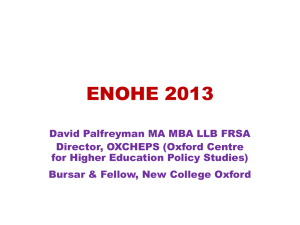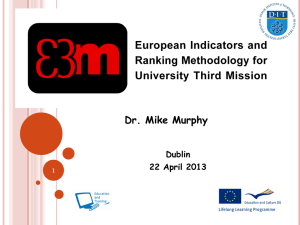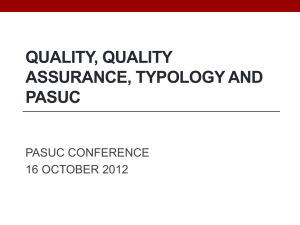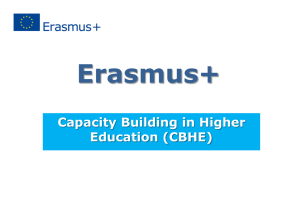Competition Within Schools: Re
advertisement
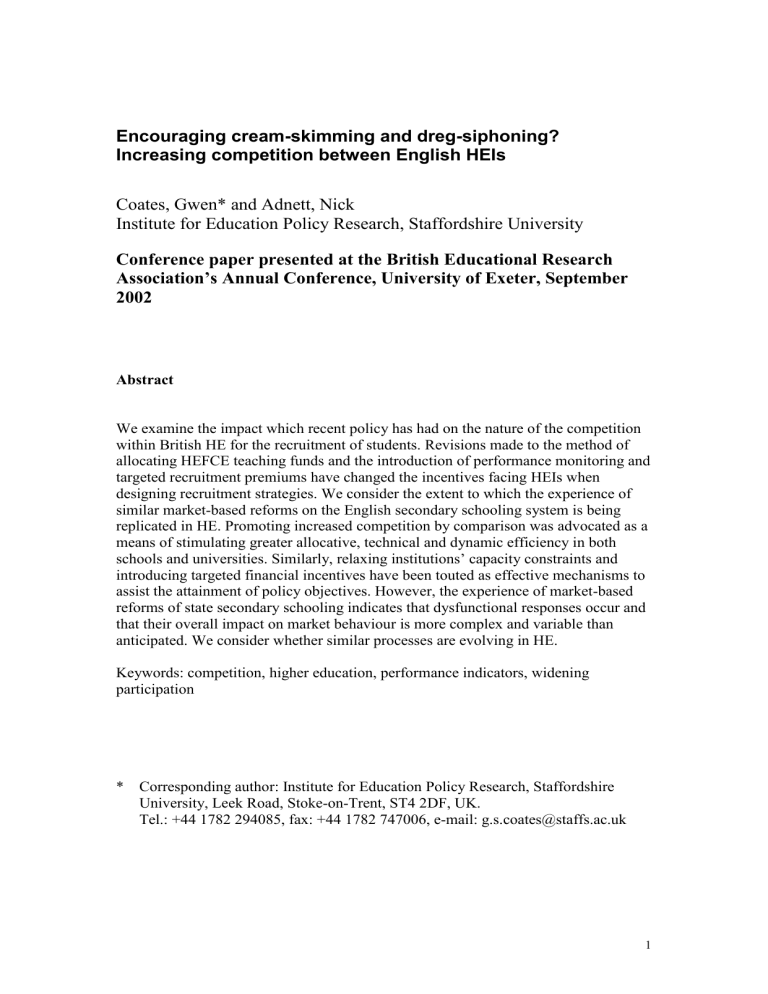
Encouraging cream-skimming and dreg-siphoning? Increasing competition between English HEIs Coates, Gwen* and Adnett, Nick Institute for Education Policy Research, Staffordshire University Conference paper presented at the British Educational Research Association’s Annual Conference, University of Exeter, September 2002 Abstract We examine the impact which recent policy has had on the nature of the competition within British HE for the recruitment of students. Revisions made to the method of allocating HEFCE teaching funds and the introduction of performance monitoring and targeted recruitment premiums have changed the incentives facing HEIs when designing recruitment strategies. We consider the extent to which the experience of similar market-based reforms on the English secondary schooling system is being replicated in HE. Promoting increased competition by comparison was advocated as a means of stimulating greater allocative, technical and dynamic efficiency in both schools and universities. Similarly, relaxing institutions’ capacity constraints and introducing targeted financial incentives have been touted as effective mechanisms to assist the attainment of policy objectives. However, the experience of market-based reforms of state secondary schooling indicates that dysfunctional responses occur and that their overall impact on market behaviour is more complex and variable than anticipated. We consider whether similar processes are evolving in HE. Keywords: competition, higher education, performance indicators, widening participation * Corresponding author: Institute for Education Policy Research, Staffordshire University, Leek Road, Stoke-on-Trent, ST4 2DF, UK. Tel.: +44 1782 294085, fax: +44 1782 747006, e-mail: g.s.coates@staffs.ac.uk 1 Encouraging Cream-skimming and Dreg-siphoning? Increasing Competition between English HEIs “One issue for consultation is whether the Council should play a greater role in managing the growth of individual institutions, to ensure that this is not at the expense of others, or of the capacity of the sector as a whole to maintain diversity and widen the participation of under-represented groups.” HEFCE (2001a). “We are not interested in propping up institutions that, through lack of quality or relevance, cannot attract enough students.” DfES ‘source’ quoted in the Independent on Sunday, (15/8/2002). 1. Introduction Since the 1970s, changes in the dominant political philosophy and business management fashions have encouraged governments to radically reform the provision of public services in many Western countries. Privatisation, competitive tendering and competition by comparison have been introduced in an attempt to increase the efficiency of provision in the public sector and enhance its accountability (Pollitt and Bouckaert, 2000). In education, the further education sector apart, reforms have so far largely avoided privatisation. Policy has concentrated upon increasing competition between educational institutions; a process accompanied by the extension of performance management and, at the margin, targeted financial incentives. In England, these market-based reforms have so far been more extensive in compulsory schooling than in HE. In this paper we utilise the consequence of the reforms of English secondary education to forecast the effects of recent UK HE policies. In general, we question whether increasing competition between HEIs creates incentives for greater efficiency, and more particularly, whether it will assist the attainment of the government’s target of 50 per cent participation by young people aged under 30 in HE by 2010. 2 HEFCE (2001b) reports that in the six years from 1988-89 to 1993-94 the number of full-time undergraduates increased by 67 per cent. In this period, the proportion of 1821 year olds participating in HE doubled to 30 per cent. Recent growth has been more modest with an increase in total student numbers of just 6 per cent between 1996-97 and 2000-01. This slowdown has produced what HEFCE initially called a ‘modest mismatch’ between the supply and demand for HE, with nearly 14,500 funded places remaining unfilled in 2000-01. The most recent data from UCAS suggest that a number of English HEIs have seen large falls in their applications as the overall market size has stabilised. In general, HEFCE (2001b) reports that those institutions most affected by this mismatch have been those who were most active in making provision for students who are part-time, mature or from disadvantaged backgrounds. While it is now recognised that such students are more expensive to teach, funding has yet to fully reflect this differential (HEFCE, 2002a) and this causes further financial problems for these institutions. This situation bears some resemblance to the ‘cycles of decline’ faced by secondary schools, that were lowly-ranked in the local schools’ hierarchy, following recent market-based reforms in England (Adnett and Davies, 2002a, Woods and Levačić, 2002). Even schools that were successful in term of educational value-added may be unable to signal this to parents and pupils, given the reliance on performance tables based upon unadjusted pupil-performance. They risked their high ability pupils being cream-skimmed by higher ranking schools, with resulting changes in the profile of their intake and the redistribution of peer-group effects further lowering their rankings in the unadjusted league tables. If their school roll declined they then lost funding and could become unable to fund the curriculum development necessary to stabilise their market share. Whether such processes are 3 also being generated in HE and to what extent more generous widening participation premiums will generate dreg-siphoning are the concerns of this paper. In the following section we briefly review the recent development of English HE policy and examine its consistency with the market choice critique of state education systems. Section 3 briefly summarises the main consequences of market-based reforms of English secondary education. Identifying similarities and differences between secondary and higher education markets and their implications for the consequences of market-based reforms is the subject matter of Section 4. Section 5 provides a summary of recent trends in student applications and recruitment into English HE. The final section combines these insights. By means of a focus upon recent HE policy, we here investigate the relevance of the recent experience of English secondary education for the development of HE in general and the attainment of widening participation targets in particular. 2. Recent English HE Policy and the Market Choice Critique The National Learning Targets specify that HE, apart from achieving the 50 per cent participation target, is required to: - achieve wider participation in the sense of a more representative social mix; make significant progress towards fair access; reduce rates of non-completion, and strengthen research and teaching excellence. In this section we concentrate upon the regulations and financial incentives which influence the ability and desire of HEIs to contribute to these targets. We ignore any policies concerning the demand for higher education. In particular, we ignore tuition fees and other mechanisms by which government has sought to switch the costs of financing 4 an increasing number of HE students from the Exchequer to the students, their families and employees (Glennerster, 2002). These individual government objectives have in turn been related to annual individual performance indicators or periodic inspection and grading. From 2002-03, HEFCE has adopted sector-wide targets for each of the first four objectives. These are likely to lead to individual targets for HEIs in the near future and the submission of widening participation strategies and targets will become a condition of grant from 2003-04 (HEFCE, 2002a). In addition, the nearly 30 per cent of HEFCE funding allocated to research is almost wholly allocated in accordance with the grades awarded in the Research Assessment Exercise. Revisions made by HEFCE to the method of allocating teaching funds in 1998-99 have increased the year-on-year variability of institutions’ HEFCE grants. Teaching funds are allocated on the basis of the number of students at an HEI. Payments adjust for the numbers in place at the end of the academic session and additional premiums reflect subject, student and institutional-related factors (HEFCE, 2002b). A tolerance band of 5 per cent is allowed between the previous year’s grant and an institution’s entitlement based upon its current position. A funding agreement then specifies weighted FTEs. HEIs whose recruitment results in their actual resources lying outside the tolerance band have in the past faced adjustments in their grants and/or student numbers in the current or subsequent years. In future, the safety net provided to institutions that under-recruit is to be withdrawn. A small ‘postcode premium’ is currently paid on the basis of an HEI’s recruitment and retention of students from geographical areas with a low HE participation rate. In 5 total this amounted to £31m in 2001-02 or 0.6 per cent of total HEFCE funding. Research undertaken by PA Consulting Group (2002) found that students from nontraditional backgrounds were significantly more expensive to recruit, retain and progress through their HE careers than traditional students. They estimated this cost differential at 30 -35 per cent, a figure greatly exceeding the additional revenues provided to HEIs through the post-code premiums and other sources of funding support for such students. In refining the incentives for HEIs to reflect the government’s widening participation agenda, HEFCE proposed in April 2002 to replace this premium with one based on the age and qualifications of students (HEFCE, 2002a). These recent HE policy changes fall well short of the full-scale liberalisation of funding and encouragement of greater and more open competition between HEIs envisaged by some market choice proponents (for example, Hare, 2000). According to this view, centralised government funding and monitoring of the quality of teaching and research is intrinsically inefficient since it precludes the operation of market forces. By regulating the student numbers that will be funded for each institution, HEFCE directly limits competition between institutions. Perceived high-quality HEIs can fill their quotas with students with previous high levels of academic attainment, but this system does not directly generate changes in market shares in response to changes in patterns of applications between HEIs. This absence of an effective entry and exit or even changing market share ‘threat’ is viewed as harmful to dynamic efficiency, since both perceived high and low-quality institutions have insufficient market incentives to improve the quality of their provision. Hence the need in the present system for supplementary quality assurance mechanisms and the use of 6 marginal financial incentives within the formula-funding system to imitate the discipline of the market. This market choice critique ignores the presence of market failures and segmentation in the HE market. Our discussion of English secondary schooling in the following section indicates that educational reforms ignoring such practicalities can generate dysfunctional responses from students and educational institutions. More specifically, dis-aggregated, high-quality information on educational value-added is not available for HEIs and the data that are available do not adjust for differences in unit costs between HEIs. This absence means that potential students, employers of graduates and government lack the information necessary to promote market efficiency. In addition, the existence of local and regional externalities, the desire to promote diversity in institutional mission and curriculum, the presence of sunk capital and the high costs of expanding and contracting individual HEI’s capacities, together suggest that unrestricted student choice is unlikely to be the optimal solution. Until recently, as we have seen, the response of government and HEFCE was to centrally manage HE provision whilst gradually introducing market-based reforms and extending its performance management system. Benchmarked performance indicators for each HEI linked to each government objective were introduced to mimic the discipline of the market. We shall argue in the following section that whilst the reforms imposed upon English secondary education produced large dysfunctional effects, the gradual and limited introduction of market-based reforms in HE initially avoided similar outcomes. 7 3. Market-Based Reforms and English Secondary Education. Market-based reforms of state secondary schooling have occurred in many Western countries over the last twenty-five years. Inter-school competition has been encouraged by a variety of measures based upon increasing parental choice. Schools have been empowered to respond to the increasing voice of consumers by the devolution of greater financial decision-making through local management of schools reforms (Adnett and Davies, 2002a). In England, market-based reforms were initiated by Conservative governments in the 1980s, and the Labour Government has largely continued with the market-orientated philosophy (Glennerster, 2002, West and Pennell, 2002). To generate greater competition by comparison, the government has published tables of school performance annually, enabling consumers to take more informed decisions. It seems clear that these reforms have in total increased the degree of competition between schools in local secondary schooling markets (Adnett and Davies, forthcoming). What is still disputed is their impact upon behaviour and outcomes in schooling markets. If we view the government as the sole principal in the schooling system we may conclude that schools, as agents, are now fulfilling more completely the principal’s objectives. The A-level pass rate has risen for the last twenty years, with more than 94.3 % of students obtaining A-E passes in 2002. The proportion of 16 year-olds in England achieving 5 grades A*- C in GCSE examinations has also risen substantially, from 35.5 % in 1992 to 57.9% in 2002. However, regardless of issues related to changing standards and the neglect of other outcome measures, we face difficulties in interpreting this improvement as proof of the benefits of more competitive markets 8 (Gorard and Taylor, 2002). Indeed, as Glennerster (2002) points out the quasi-market reforms have had their greatest impact on secondary schools whilst attainment levels have been rising most rapidly in primary schools. A key concern has been whether improvements in educational attainments have been evenly spread across schools and pupils, in other words the nature of any efficiencyequity trade-off. Cream skimming, and/or the increased exercise of parental preferences, reallocate positive peer group effects away from lower-ranked schools. Effectively, open enrolment systems privatise ownership of the beneficial externalities produced by able pupils, with both parents and schools seeking to obtain the most favourable mix of peer group effects. The net impact of open enrolment on overall stratification of pupils by social class and ability in England is currently much debated. Gorard and Fitz’s (2000a, 2000b) finding that at national, regional and local government level segregation has fallen has been challenged by Bradley and Taylor (2000) and Goldstein and Noden (2002) as well as by researchers using in-depth studies of parental choice (e.g. Gewirtz et al., 1995). The Chief Inspector of Schools in England has also noted a widening gap between the performance of pupils in the highest and lowest ranking schools (OfSTED, 1999). Glennerster’s (2002) analysis of performance at Key Stage 3 (14 years of age) whilst confirming the continuing huge differences between schools suggests that this gap has not widened since 1995. In summary, greater competition in English secondary schooling markets seems to have promoted higher levels of academic attainment, but school choice reforms have a tendency to reinforce local schooling hierarchies, reduce the diversity of provision and increase or maintain the large differences in the mean pupils’ academic 9 attainment between schools. Perhaps the greatest failure of the quasi-market reforms, as Glennerster (2002) points out, is that schools now face incentives to favour high ability entrants and those with fewer problems. We shall argue that this policy failure has been replicated in HE. 4. Distinguishing Features of the English HE Market The government’s prime motivation for reforming English state secondary schooling was based upon the perceived needs to improve standards. There has been much less concern with standards in HE, instead the emphasis on the supply side of the market has been upon generating growth in capacity at minimum cost to the Exchequer. Policy in both sectors has, however, been concerned to improve accountability and reflect current management fashion. This has produced a similar emphasis upon inspection and performance monitoring. HE and secondary education share some distinctive characteristics that cause simple models of competitive market behaviour to be inappropriate. They produce multiple outputs that cannot always be measured accurately and these outputs are characterised by large positive externalities. They both contain multiple principals with diverse preferences and are staffed by teachers who are in part motivated by professional and public service considerations. Asymmetries of information make parents and students highly vulnerable to providers’ opportunism, and in part explain the limited role of ‘for-profit’ providers. Finally, both sectors use a ‘customer-input technology’. Students educate themselves and each other, and the quality of education provided by an institution depends significantly on the quality of the students’ peers (Winston, 10 1999). Institutions can use peer inputs as a substitute for other inputs; hence institutions that attract high-ability students can continue to employ inferior resources or less effective teaching and learning techniques over time. In addition to these common characteristics, we identify six particular differences that are of interest to us in assessing the impact of market-based reforms in HE. Firstly, secondary schooling consists of heterogeneous local markets, characterised by a wide range of competitive, co-operative and collusive behaviour (Adnett and Davies, forthcoming), whereas geographical mobility of students is much higher in HE and local students are a small minority in most HEIs. Though students from the lessaffluent social classes tend to travel less far to their HEI than those from the more affluent social classes (HEFCE, 2001b). Hence the HE market is more national, which means that collusion to restrict competition is more difficult and co-operation between HEIs less likely. Market forces are therefore less easily avoided or subverted in HE, although the presence of specialist HEIs and restrictions on the provision of certain subjects, e.g. medicine, creates niches where competition is more oligopolistic. These characteristics, together with the experience of the secondary schooling sector suggest that Meek (2000) was correct in arguing that increased competition between HEIs would reduce diversity in the HE sector. Secondly, in both sectors the use of a customer-input technology generates a strong feedback as the quality of present students influences potential applicants thereby sustaining student quality and creating stable hierarchies (Winston, 1999). However, in secondary schooling, hierarchies of institutions are predominantly local and have been reinforced by the introduction of performance tables. In HE, hierarchies are 11 national and predominantly based upon input, rather than output, measures of student ability. This is largely due to absence of external exit exams in UK HE that prevent the type of comparisons between educational institutions’ performances popularised in school league tables. Though in contrast with the secondary sector, performance monitoring in HE has not predominantly sought to provide information accessible to parents and students. Thirdly, a further consequence of the national market in HE and the national system of application are that stratification by previous academic attainment has traditionally been high. This in part may reflect positional or status competition (Adnett and Davies, 2002b), where students apply to HEIs with high entry standards because of the prestige associated with exclusivity or scarcity, such effects are more likely when the system allows applicants to make multiple applications (Abbot and Leslie, 2002). The problems faced by students and employers in measuring output levels in HE are also likely to encourage prospective students to apply to HEIs with more highlyqualified students. Whilst this behaviour may partly reflect peer group effects on performance (Epple et al., 2002), or the ability of such institutions to hire more effective staff, it may also be the result of the prospect of higher graduate earnings for a given level of attainment. A consequence of the asymmetric information problem faced by employers of graduates. Hence we would expect a persistent excess demand for places in such elite institutions, unless the higher risk of failure is sufficient to deter prospective entrants1. Fourthly, differences in HEIs’ total resources per student are much greater than those found in state secondary schools. In part this reflects a greater diversity of outputs in 12 HEIs. Significantly, it allows some HEIs to cross-subsidise to gain strategic advantages to a much greater extent than is possible in secondary education. For students, these subsidies may take the form of better buildings, sports facilities and student services or more computers and smaller classes. Fifthly, ignoring demographic factors, the overall market size is more variable in HE. Participation rates in HE can change significantly over relatively short-periods of time, whilst the longer duration of secondary schooling and the requirement that schooling is compulsory up to age 16 dampens the movements in the size of the secondary schooling market. In both sectors the exit of existing institutions and entry of new ones has in the past been rare, although in HE significant capacity increases have been more common. Although both sectors’ markets adjust through both changes in quantity and quality (intake ability), in HE a lower limit is set on entry qualifications. Hence, in times of contracting or stable market size those HEIs at the bottom of the hierarchy, and without buoyant local markets, may be particularly squeezed. Finally, non-completion is more of a concern in HE, though non-completion is notoriously difficult to measure for the 16-18 age group and in both sectors this outcome is strongly related to previous educational experience. Johnes and McNabb (2001) find that both voluntary and involuntary non-completions in HE are negatively related to intake qualifications. Those who gained entry to HE on the basis of ALevels or Scottish Highers were less likely to drop out of university than were those entrants with other types of qualifications. Interestingly for our later discussion, Light and Stayer (2000) found that low-ability students were more likely to drop out from ‘higher quality’ institutions than they were from ‘low quality’ institutions. Noncompletion rates for more able students initially increase and then fall as the quality of 13 the HEI increases. Johnes and McNabb (2001) also found that peer groups and the quality of the match between students and their university were important determinants of student retention. Whilst we are interested in the similarities in market-based reforms in the two sectors we need to acknowledge two important differences. First, performance monitoring in HE has avoided many of the dysfunctional effects induced by the introduction of school performance tables based upon unadjusted pupil performance (Adnett and Davies, forthcoming). The chosen indicators of widening participation, completion, efficiency and employment have each been benchmarked to reflect the subject mix and entry qualifications of individual HEIs. Differences between actual performance and benchmarks are then subjected to significance tests, the results of which are reported in the published tables. Data limitations however, restrict the usefulness of these indicators to students and governments wishing to assess relative private or social rates of return or employers trying to proxy the relative quality of an HEI’s output. Second, in the secondary schooling sector the funding formulae mean that marginal revenues and average revenues per student are generally equal, whereas up to capacity, marginal costs are lower than average costs. Hence, schools usually have an incentive to recruit up to their Planned Admission Number. In HE the present funding system means that any HEI considering recruiting above their contracted FTEs face, in the year of entry2, a marginal revenue per student, perhaps only fee income, significantly lower than their average revenue. However, the actual intake decision concerns comparing this marginal revenue with marginal costs. As we have seen, if 14 we accept HEFCE’s argument that the participation rate of traditional students cannot be further increased, then system-wide, the marginal cost of additional students to the HE system as a whole greatly exceeds the average cost of the mean (traditional) student. However, this will not be true for all individual HEIs. The marginal students for high and middle-ranked HEIs will typically be traditional students with slightly lower academic achievements than their current intake. As such their marginal costs may be low enough to encourage the HEI to exceed their contracted FTEs. As a consequence, effectively lower ranked institutions find that their highest-qualified applicants have been cream-skimmed. They are therefore faced with achieving their contracted FTEs through increasing the proportion of nontraditional students whose marginal costs to the institution substantially exceed their marginal revenue. Hence, those institutions trading at this margin face a chronic under-funding problem at a time when their market share is falling. The higher drop out rate of these non-traditional students means that these problems are likely to intensify over time, unless market size grows faster than the sectors’ overall capacity. Whether there is any evidence that these processes are actually present in English HE is addressed in the following section. 5. Recent Trends in Student Recruitment To date HEFCE has limited competition between institutions by regulating student numbers that will be funded for each institution. We suggested in Section 2 that the gradual and limited introduction of market-based reforms in HE did perhaps avoid the dysfunctional outcomes evident in English secondary education. However, now that 15 the effective cap on student numbers has been removed, this means that limitations on competition for student numbers have also gone. In such a situation, the ‘mismatch’ between supply and demand identified by HEFCE (2001b) might therefore cause the more popular institutions to flourish at the expense of the less popular ones. Over the last 25 years, the post-1992 or ‘new’ universities grew rapidly at first but more recently, as the overall market size for undergraduate HE stabilised, they have generally suffered declining applications. The pre-1992 or ‘old’ universities, on the other hand, experienced much slower, but steady, growth throughout the same period and have not, in general, been affected by the recent falling off of overall demand; many in fact have seen an increase in applications. In recent years, a number of English HEIs have seen large changes in applications to their institutions. Table 1 provides a summary of those institutions experiencing changes of 10% or more in applications to their institutions for 2001/02. It is interesting to note that of those showing the greatest decline in applications, only one, the University of Bradford, is a pre-1992 or ‘old’ university and of those universities showing the greatest increase in applications, only one, the University of Portsmouth, is a post 1992 or ‘new’ university. 16 Table 1, % Change in Higher Education Applications to first degrees, 2001/2002 (% Change 2000/2001 in second bracket), (England only) Those with a 10% or more fall Those with a 10% or more rise 1. Luton 2. Bradford 3. South Bank 4. Staffordshire 5. De Montfort 6. Huddersfield 7. North London 8. Sunderland 9. Anglia Polytechnic 10. Herfordshire 11. Wolverhampton 12. East London 13. London Guildhall 14. Thames Valley 15. Coventry 1. Surrey 2. Oxford 3. East Anglia 4. Portsmouth 5. York 6. Nottingham 7. Manchester 8. Newcastle 9. LSE 10. Durham 11. Cambridge 12. Warwick 13. Queen Mary, London 14. Bristol 15. Sheffield 16. Exeter 17. City 18. Keele 19. Kent at Canterbury 25.7 21.6 21.1 19.9 18.6 16.7 14.4 12.6 12.3 12.2 12.2. 11.5 10.2 10.1 10.0 (-0.8) (+2.3) (-6.6) (-5.4) (-7.0) (+0.8) (-10.0) (-12.0) (+12.5) (-8.5) (+6.0) (-12.8) (-12.2) (-7.7) (+0.2) 22.7 17.9 17.6 17.5 16.7 16.5 16.4 16.4 15.7 15.5 14.7 14.6 12.3 11.8 11.8 11.5 11.0 10.9 10.8 (-3.7) (+4.7) (+0.4) (-5.3) (+0.9) (+6.4) (-2.7) (+3.8) (-1.3) (-0.8) (-7.3) (-2.5) (-2.9) (-1.3) (-7.9) (+6.7) (-3.4) (+4.8) (+3.1) (Adapted from UCAS, Higher Education Applications, 2001 and 2002, at www.ucas. ac.uk) As in the school sector, a decline in enrolments for individual HEIs is likely to lead to budgetary constraints. Thus while the market may provide incentives for competition and curriculum reform, these HEIs will lack the necessary resources to fund such innovations. (Davies et al, 2002). Again as in the school sector, the experience of schools low in the league tables might be replicated in the case of the post 1992 institutions. These institutions might well be successful in adding value to their applicants but are clearly unable to signal this to potential students; high quality information on educational value added being unavailable for HEIs. Given the pattern 17 of applications shown in Table 1, and average A Level grade points (Tables 4 and 5) for these same institutions, it is possible that high ability students from the ‘new’ universities, are likely to be creamed off by those ‘old’ universities showing a significant increase in applications. Taken to its logical conclusion, this decline in entrants and the consequent reductions in funding may eventually lead to closure, as suggested by the DfES civil servant’s quote in the Independent on Sunday provided at the beginning of this paper. However of some concern in relation to the government’s target of a 50% participation rate in undergraduate HE, is that those institutions most affected by this ‘mismatch’ between supply and demand appear to be the post 1992 or ‘new’ universities. These HEIs being those most active in making provision for students from non-traditional backgrounds and most prominent in terms of widening participation activity. Tables 2 and 3 show that those institutions with the highest benchmarks for both entrants from Social Class IIIM, IV and V and from low participation neighbourhoods are almost all institutions that have suffered reductions of 10 per cent or more in applications and are all post-1992 or ‘new’ universities. 18 Table 2, Young full-time first-degree entrants from Social Class IIIM, IV, V, 1999 – 2000 (HEIs with high benchmarks and a rise (^) or fall (*) of 10% or more in applications +/- Indicates performance significantly better or worse than benchmark) (England only) Benchmarks of 30% or more Anglia Polytechnic (31) Bolton Institute (32) (+) Coventry (31) (+) De Montfort (30) (+) East London (33) (+) Hertfordshire (30) (+) Huddersfield (31) (+) Luton (33) North London (34) (+) South Bank (32) Staffordshire (31) (+) Sunderland (32) (+) Thames Valley (34) Wolverhampton (32) (+) * * * * * * * * * * * * * * (Adapted from HECFCE Performance Indicators, 1999/2000, Table T1a and UCAS HE Applications, 2002) Table 3, Young full-time first-degree entrants from low participation neighbourhoods, 1999 – 2000 (HEIs with high benchmarks and a rise (^) or fall (*) of 10% or more in applications +/- Indicates performance significantly better or worse than benchmark) (England only) Benchmarks of 14% or more Anglia Polytechnic (15) Coventry (14) De Montfort (14) East London (15) London Guildhall (15) Luton (15) North London (15) Portsmouth (14) South Bank (16) Staffordshire (15) Sunderland (15) Thames Valley (16) Wolverhampton (15) (+) (-) (-) (+) (+) * * * * * * * ^ * * * * * (Adapted from HECFCE Performance Indicators, 1999/2000, Table T1a and UCAS HE Applications, 2002) 19 Unlike the situation in schools, any hierarchy of HEIs tends to be based on input measures of student ability, rather than output measures. As mentioned in Section 4, the absence of external exit exams in UK HE limits the ability to compare the performance of educational institutions. Such problems of measuring output levels in higher education encourage prospective students to apply to those HEIs that attract high quality students. This behaviour is likely to lead to an excess demand for places in elite institutions that attract high quality students. We noted in Section 3 that there is a widening gap between the performance of pupils in the highest and lowest ranking secondary schools. In Section 4 we suggested that the quality of education provided by an institution depends significantly on the quality of a students’ peers. If the quality of a students’ peers is measured by A Level grades, then HEIs in the ‘Bottom Twenty’ list in Table 4 are unlikely to be sustaining a high quality of education. The majority of these institutions have also suffered significant reductions in applications, which in turn will have implications for funding and therefore quality. 20 Table 4 Average A Level scores and applications Average A Level scores over 5 years to 1999/2000 and whether experiencing a rise (^) or fall (*) of 10% or more in applications (A grade = 10 points, B grade = 8, etc.) Top Twenty 1. Cambridge 2. Oxford 3. LSE 4. Imperial College 5. Bristol 6. Nottingham 7. Warwick 8. Durham 9. Sheffield 10. University College 11. York 12. Bath 13. Birmingham 14. Manchester 15. King’s, London 16. Leeds 17. Queen’s, Belfast 18. Cardiff 19. Newcastle 20. Exeter Bottom Twenty (^) (^) (^) (^) (^) (^) (^) (^) (^) (^) (^) (^) 29.5 29.1 27.5 27.4 26.1 26.0 25.3 25.2 24.8 24.6 24.5 24.1 24.1 23.7 23.4 23.4 23.1 22.6 22.5 22.4 1. North London 2. Thames Valley (*) (*) 3. Luton (*) 4. South Bank 5. Greenwich 6. East London 7. London Guildhall 8. Sunderland 9. Teeside 10. Wolverhampton 11. Glamorgan 12. Lincoln 13. Brighton 14. Middlesex 15. Derby 16. Anglia Polytechnic 17. Coventry 18. Staffordshire 19. Westminster 20 De Montfort (*) (*) (*) (*) (*) (*) (*) (*) (*) 9.6 10.3 10.9 11.2 11.7 11.8 11.9 12.1 12.4 12.5 12.5 12.5 12.6 12.6 12.7 12.9 12.9 13.0 13.1 13.2 (Kingston, B. ‘Trends in A Level Grades’, THES, 07.06.02) As low ranked institutions find their highest qualified applicants have been creamskimmed, they can only achieve their contracted FTEs by increasing the proportion of non- traditional students (whose marginal cost is greater then their marginal revenue). In turn these non-traditional students have higher costs and dropout rates, which intensifies the problem of underfunding consequent on a fall in applicants. 21 The average rate of qualifying, i.e. completion, in UK HE is 83%, which is greater than many international competitors (HEFCE, 2001b). However, there are wide variations between HEIs in their non-completion rates and this is largely related to the students’ prior level of educational achievement, which in turn is strongly associated with social class. This is illustrated in Table 5, which provides data on HEIs with the highest and lowest benchmarks for non-continuation (or non-completion). It can be seen that there is a clear relationship between those institutions with the highest benchmarks (that is where non-completion is expected to be relatively high) and lower average A Level scores. Again it is important to note that the majority of these institutions are also those suffering the greatest reduction in applications and those with the highest benchmarks for participation from lower socio-economic classes and from low participation neighbourhoods (Tables 2 and 3). Conversely, those institutions with the lowest non-continuation benchmarks are also those with the highest average A Level scores, a large proportion of which have experienced substantial increases in applications. Table 5 Non-continuation and A Level Grade Points Benchmarks for Non-continuation following year of entry for Young Full-time first degree entrants 1998 - 99 (England only) 3 year rolling average A Level grade points for (96/7/8), (97/8/9), (98/9/2000) The final figure is the change in the 3-year average Non-Continuation Benchmarks greater than 10% Central England in Birmingham (11) (14.0, 14.0, 14.1) Coventry * (11) (12.6, 12.9, 13.3) De Montfort * (11) (13.1, 13.2, 13.4) Derby (11) (12.7, 12.7, 12.7) East London* (13) (11.6, 11.8, 12.1) Greenwich (11) (11.6, 11.7, 11.8) Hertfordshire * (11) (12.5, 12.8, 13.7) Huddersfield * (11) (12.9, 13.5, 13.6) +0.1 +0.7 +0.3 0.0 +0.5 +0.1 +1.2 +0.7 22 London Guildhall * Luton * Middlesex North London * South Bank * Sunderland * Teesside Thames Valley * Westminster Wolverhampton * (12) (13) (11) (13) (13) (11) (11) (13) (11) (11) (12.1, 11.8, 11.8) (10.8, 11.1, 10.8) (12.6, 12.8, 12.8) (8.5, 9.4, 10 4) (11.0, 11.2, 11.5) (11.8, 12.1, 12.4) (12.2, 12.2, 12.6) (10.1, 10.4, 10.1) (12.8, 13.3, 13.5) (12.5, 12.6, 12.6) -0.3 -0.2 +0.2 +1.9 +0.5 +0.6 +0.4 0.0 +0.7 +0.1 (*10% or more fall in applications) Non-Continuation Benchmarks less than or equal to 5% Bath (4) (23.3, 24.1, 25.0) Birmingham (4) (24.0, 24.3, 24.2) Cambridge ^ (2) (29.4, 29.7, 29.7) Durham ^ (4) (25.2, 25.0, 25.2) Exeter ^ (5) (22.0, 22.4, 22.9) Imperial College (3) (27.1, 22.5, 22.7) King’s College London (5) (22.8, 23.6, 24.1) Lancaster (5) (21.4, 21.9, 21.9) Leeds (5) (31.1, 23.4, 23.7) Leicester (5) (21.1, 21.5, 21.8) Liverpool (5) (21.5, 21.8, 21.5) LSE ^ (3) (27.2, 27.6, 28.0) Manchester ^ (5) (23.6, 23.9, 23.8) Newcastle ^ (5) (22.1, 22.7, 23.0) Nottingham ^ (4) (25.9, 26.1, 26.1) Oxford ^ (2) (28.9, 29.1, 29.4) Sheffield ^ (4) (24.2, 25.1, 25.4) University College London (4) (24.2, 25.2, 25.4) Warwick ^ (4) (24.8, 25.6, 26.0) York ^ (4) (23.9, 24.6, 25.1) +1.7 +0.2 +0.3 0.0 +0.8 +0.6 +1.3 +0.5 +0.6 +0.7 0.0 +0.8 +0.3 +0.9 +0.2 +0.5 +1.2 +1.2 +1.2 +1.2 (^ 10% or more rise in applications) ((Adapted from HECFCE Performance Indicators, 1998/1999, Table T3a and UCAS HE Applications, 2002 and (Kingston, B. ‘Trends in A Level Grades’, THES, 07.06.02) 23 6. Conclusions Until recently, market-based reforms of English HE have avoided many of the dysfunctional effects identified in the secondary sector. Performance monitoring in HE has been extended, but in a way that is much more sensitive to the dangers of providing distorted signals to stakeholders. However, the failure to fund the higher costs of non-traditional entrants means that HEIs face the same incentives to favour traditionally qualified entrants and those with fewer problems that we noted in the secondary schooling sector. The relaxation of restrictions on an HEIs’ maximum student numbers is likely to further increase stratification in English HE. However, high quality HEIs, in terms of value-added, have difficulty in signalling their quality in the marketplace. A number of processes discussed above make the hierarchy of HEIs stable and insensitive to actual performance. Hence, in contrast to the comments of the DfES spokesperson, market success may be much less dependent on quality or relevance than on history and regional location. 24 Footnotes 1. It need not follow that ‘elite’ universities should have high failure rates to deter such behaviour. The costs resulting from the reduced efficiency of sorting have to be offset against, in the absence of strong learning effects, the social costs of able students not completing HE. 2. The longer-term financial consequences of recruiting additional students depends upon whether the funding council increases future contracted FTEs. 25 References ABBOTT, A. and LESLIE, D. Recent Trends in Higher Education Applications and Acceptances, Manchester Metropolitan University Discussion Papers in Economics. ADNETT, N. and DAVIES, P. (2002a) Markets for Schooling: An economic analysis, London: Routledge. ADNETT, N. and DAVIES, P. (2002b) Education as a positional good: Implications for market-based reforms of state schooling, British Journal of Educational Studies, 50(2): 189-205. ADNETT, N. and DAVIES, P. (forthcoming) Schooling Reforms in England: From quasi-markets to co-opetition? Journal of Education Policy. BRADLEY, S. and TAYLOR, J. (2000) The effect of the quasi-market on the efficiency-equity trade-off in the secondary school sector, Lancaster University Management School Discussion Paper EC9/00. DAVIES, P., ADNETT, N. and MANGAN, J. (2002) The Diversity and Dynamics of Competition: evidence from two local schooling markets, Oxford Review of Education, 28(1): 91-107. EPPLE, D., ROMANO, R. and SIEG, H. (2002) On the Demographic Composition of Colleges and Universities in Market Equilibrium, American Economic Review, 92(2): 310-4. GEWIRTZ, S., BALL, S. and BOWE, R. (1995) Markets, Choice and Equity in Education, Buckingham: Open University Press. GLENNERSTER, H. (2002) United Kingdom Education 1997-2001, Oxford Review of Economic Policy, 18(2): 120-36. GOLDSTEIN, H. and NODEN, P. (2002) Modelling Social Segregation, mimeo. 26 GORARD, S. and FITZ, J. (2000a) Investigating the determinants of segregation between schools, Research Papers in Education 15, 2: 115-132. GORARD, S. and FITZ, J. (2000b) Markets and stratification: a view from England and Wales, Educational Policy 14, 3: 405-428. GORARD, S. and TAYLOR, C. (2002) Market Forces and Standards in Education: a preliminary consideration, British Journal of Sociology of Education, 23(1): 5-18. HARE, P. (2000) Constraints and Incentives in the UK University System, HeriottWatt University, School of Management, Economics Division, Discussion Paper No. 2000/3. HIGHER EDUCATION FUNDING COUNCIL FOR ENGLAND (HEFCE) (2001a) Expansion of student numbers depends on raising aspirations, Press Release 22 October 2001. HIGHER EDUCATION FUNDING COUNCIL FOR ENGLAND (HEFCE) (2001b) Supply and Demand in Higher Education, 01/62, HEFCE: Bristol. HIGHER EDUCATION FUNDING COUNCIL FOR ENGLAND (HEFCE) (2002a) Funding for Widening Participation in Higher Education, 02/22, HEFCE: Bristol. HIGHER EDUCATION FUNDING COUNCIL FOR ENGLAND (HEFCE) (2002b) Funding Higher Education in England: How the HEFCE allocates its funds, 02/18, HEFCE, Bristol. JOHNES, G. and McNABB, R. (2001) Never Give Up on the Good Times: Student Attrition in the UK, Lancaster University Management School Discussion Paper EC12/01. MEEK, V. (2000) Diversity and Marketisation of Higher Education: Incompatible concepts?, Higher Education Policy, 13: 23-49. 27 OFFICE FOR STANDARDS IN EDUCATION (OfSTED) (1999) The Annual Report of Her Majesty’s Chief Inspector of Schools, London: The Stationery Office. PA CONSULTING GROUP (2002) Determining the Costs of Widening Participation: Report of a Pilot Study, PA Knowledge Ltd., London. POLLITT, C. and BOUCKAERT, G. (2000) Public Management Reform: A comparative analysis, Oxford: Oxford University Press. WEST, A. and PENNELL, H. (2002) How New is New Labour? The Quasi-market and English schools 1997 to 2001, British Journal of Educational Studies, 50(2): 20624. WINSTON, G. (1999) Subsidies, Hierarchy and Peers: The awkward economics of higher education, Journal of Economic Perspectives, 13(1): 13-36. WOODS, P. and LEVAČIĆ, R. (2002) Raising School Performance in the League Tables (Part 2): barriers to responsiveness in three disadvantaged schools, British Educational Research Journal, 28(2): 227-47. 28

